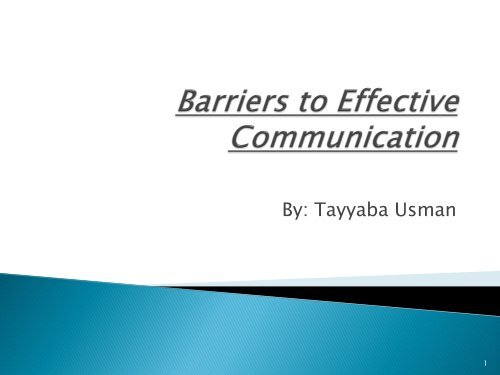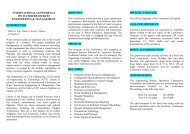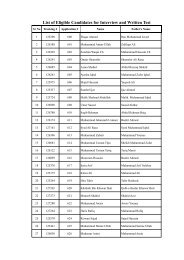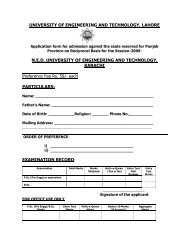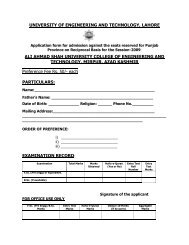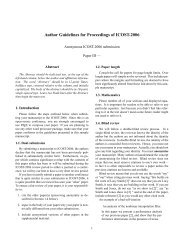Barriers to Effective Communication
Barriers to Effective Communication
Barriers to Effective Communication
Create successful ePaper yourself
Turn your PDF publications into a flip-book with our unique Google optimized e-Paper software.
By: Tayyaba Usman<br />
1
"A barrier <strong>to</strong> communication is something that<br />
keeps meanings from meeting. Meaning barriers<br />
exist between all people, making communication<br />
much more difficult than most people seem <strong>to</strong><br />
realize. It is false <strong>to</strong> assume that if one can talk<br />
he can communicate. Because so much of our<br />
education misleads people in<strong>to</strong> thinking that<br />
communication is easier than it is, they become<br />
discouraged and give up when they run in<strong>to</strong><br />
difficulty. Because they do not understand the<br />
nature of the problem, they do not know what <strong>to</strong><br />
do. The wonder is not that communicating is as<br />
difficult as it is, but that it occurs as much as it<br />
does."<br />
2
When people are under stress, they are more<br />
apt <strong>to</strong> inject communication barriers in<strong>to</strong><br />
their conversation. These barriers can exist in<br />
any of the three components of<br />
communication (verbal, paraverbal, and<br />
nonverbal).<br />
3
.According <strong>to</strong> Thomas Gordon, author of the<br />
Parent <strong>Effective</strong>ness Training program, people<br />
use communication barriers 90% of the time<br />
in conflict situations. For this reason, it is<br />
worthwhile <strong>to</strong> describe some of the common<br />
responses that will, inevitably, have a<br />
negative effect on communications:<br />
4
1. Attacking (interrogating, criticizing,<br />
blaming, shaming)<br />
5
"If you were doing your job and supervising<br />
Susie in the lunch line we probably wouldn't<br />
be in this situation, would we?"<br />
"Have you followed through with the<br />
counseling we asked you <strong>to</strong> do? Have you<br />
gotten Ben <strong>to</strong> the doc<strong>to</strong>r's for his medical<br />
checkup? Did you call and arrange for a Big<br />
Brother? Have you found out if you're eligible<br />
for food stamps?"<br />
6
"From what I can see, you don't have the<br />
training <strong>to</strong> teach a child with ADHD.<br />
Obviously if you did you would be using<br />
different strategies that wouldn't make her<br />
feel like she's a bad person."<br />
7
"You don't seem <strong>to</strong> understand how<br />
important it is for your child <strong>to</strong> get this help.<br />
Don't you see that he's well on his way <strong>to</strong><br />
becoming a sociopath?“<br />
"You obviously don't realize that if you were<br />
following the same steps we do at home you<br />
wouldn't be having this problem. You don't<br />
seem <strong>to</strong> care about what ís going on in this<br />
child's life outside of school."<br />
8
"If you don't voluntarily agree <strong>to</strong> this<br />
evaluation we can take you <strong>to</strong> due process.<br />
Go ahead and file a complaint if you want <strong>to</strong>.“<br />
"I'm going <strong>to</strong> write a letter of complaint <strong>to</strong> the<br />
superintendent and have this in your file if<br />
you don't s<strong>to</strong>p humiliating my son in front of<br />
his classmates. I know my rights."<br />
9
4. Other Verbal <strong>Barriers</strong>: shouting, name<br />
calling, refusing <strong>to</strong> speak.<br />
10
1. Flashing or rolling eyes<br />
2. Quick or slow movements.<br />
3. Arms crossed, legs crossed<br />
4. Gestures made with exasperation<br />
5. Slouching, hunching over<br />
6. Poor personal care<br />
7. Doodling<br />
8. Staring at people or avoiding eye contact<br />
9. Excessive fidgeting with materials<br />
11
All of these examples of barriers<br />
thwart communication, mutual<br />
understanding, respect, problem<br />
solving, and identifying solutions that<br />
will meet everyone's needs. They put a<br />
serious strain on relationships that<br />
ultimately need <strong>to</strong> be collaborative in<br />
order <strong>to</strong> most effectively meet the<br />
needs of our children. Use of these<br />
"communication errors" results in<br />
increased emotional distancing<br />
between the parties, escalation in the<br />
intensity of the conflict and a negative<br />
environment for everyone involved.<br />
12
It is two way.<br />
It involves active listening.<br />
It reflects the accountability of speaker and<br />
listener.<br />
It utilizes feedback.<br />
It is free of stress.<br />
It is clear.<br />
13


